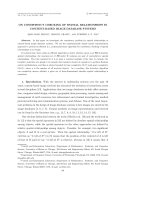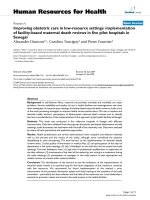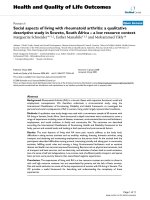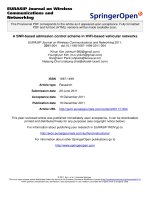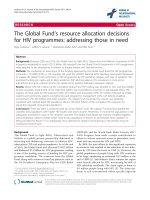a two-step resource allocation algorithm in multicarrier based cognitive radio systems
Bạn đang xem bản rút gọn của tài liệu. Xem và tải ngay bản đầy đủ của tài liệu tại đây (244.14 KB, 6 trang )
A Two-Step Resource Allocation Algorithm in
Multicarrier Based Cognitive Radio Systems
Musbah Shaat and Faouzi Bader
Centre Tecnol
`
ogic de Telecomunicacions de Catalunya (CTTC)
Parc Mediterrani de la Tecnolog
´
ıa, Av. Carl Friedrich Gauss 7, 08860 , Castelldefels-Barcelona, Spain.
Phone: +34 93 6452911, Fax: +34 93 6452900
Email:{musbah.shaat,faouzi.bader}@cttc.es
Abstract— This paper presents a two-step downlink resource
allocation algorithm for multicarrier based cognitive radio sys-
tems. The algorithm allocates the subcarriers to the users in the
first step. In the second step, the power is allocated to these
subcarriers in order to maximize the downlink capacity of the
system without causing excessive interference to the primary
user. The performance of the proposed algorithm is investigated
using computer simulations to prove that it achieves near optimal
performance and it is better than other existing algorithms.
Moreover, the throughput of Orthogonal frequency division mul-
tiplexing (OFDM) and filter bank multicarrier system (FBMC)
based cognitive radio systems are compared to show the efficiency
of using FBMC in future cognitive radio systems.
Index Terms- Cognitive Radio; OFDM; FBMC; Power A lloca-
tion; resource management.
I. INTRODUCTION
Cognitive Radio (CR) was first introduced by Mitola [1] as a
radio that can change its parameters based on interaction with
the environment in which it operates. According to Federal
Communications Commission (FCC) [2], temporal and geo-
graphical variation in the utilization of the assigned spectrum
range from 15% to 85% which means that assigning frequency
bands to specific users or service providers exclusively doesn’t
guarantee that the bands are being used efficiently all the time.
The CR technology aims to increase the spectrum utilization
by allowing a group of unlicensed users [referred to as
secondary users (SU’s)] to use the licensed frequency channels
(spectrum holes) without causing a harmful interference to the
licensed users [referred to as primary users (PU’s)] and thus
implement efficient reuse of the licensed channels.
Multicarrier communication systems have been considered
as an appropriate candidate for CR systems due to its flexibility
in allocating different resources among different users as well
as its ability to fill the spectrum holes left by the PU’s
[3]. In [4], the mutual interference between PU and SU was
studied. The mutual interference depends on the transmitted
power as well as the spectral distance between PU and SU.
Orthogonal frequency division multiplexing (OFDM) based
CR system suffers from high interference to the PU’s due to
large sidelobes of its filter frequency response. The insertion
of the cyclic prefix (CP) in each OFDM symbol decreases the
system capacity. The filter bank multicarrier system (FBMC)
doesn’t require any CP extension and can overcome the
spectral leakage problem by minimizing the sidelobes of each
subcarrier and therefore lead to high efficiency (in terms of
spectrum and interference) [5] [6].
The problem of resource allocation for conventional (non-
cognitive) multicarrier systems has been widely studied (e.g.
[7]–[10] and references therein). All of the classical algorithms
that was proposed to solve the problem in conventional multi-
carrier systems cannot be applied to the CR systems due to the
existence of the two different types of users (PU’s and SU’s)
where the interference introduced to the PU’s by the SU’s
should be taken into consideration. In [11], the authors pro-
posed an optimal and two suboptimal power loading schemes
using the Lagrange formulation to maximize the downlink
capacity of the CR system while keeping the interference in-
duced to only one PU below a pre-specified threshold without
the consideration of the total power constraint. P.Wang et al. in
[12] proposed an iterative partitioned single user waterfilling
algorithm. The algorithm aims to maximize the capacity of
the CR system under the total power constraint with the
consideration of the per subcarrier power constraint caused by
the PU’s interference limit. The mutual interference between
the SU and PU was not considered. In [13], an algorithm called
RC algorithm was presented for multiuser resource allocation
in OFDM based CR systems. This algorithm uses a greedy
approach for subcarrier and power allocations by successively
assign bits, one at time, based on minimum SU power and
minimum interference to PU considerations. The algorithm has
a high computational complexity and a limited performance
with comparison to the optimal solution.
In this paper, a two-step multiuser resource allocation
algorithm in multicarrier based CR systems in downlink is
proposed. In the first step, the subchannels are assigned to
users and then in the second step, the powers are allocated
to the different subcarriers in order to maximize the downlink
capacity of the CR system under both the interference and
power constraints. The efficiency of the proposed algorithm
will be investigated in OFDM and FBMC based CR systems.
The rest of this paper is organized as follow: Section II gives
the system model and formulates the problem. The subcarrier
to user assignment is described in Section III. In Section IV,
the power allocation algorithm is presented. Numerical results
are given in Section V while Section VI concludes the paper.
CR base station
(CBS)
Primary system
base station
Secondary User
(SU)
(SU)
Primary User
(PU)
(PU)
Fig. 1. Cognitive Radio Network
II. SYSTEM MODEL AND PROBLEM FORMULATION
In this paper, the downlink scenario will be considered.
As shown in Fig. 1, the CR system coexist with the PU’s
radio in the same geographical location. The cognitive base
station (CBS) transmits to its SU’s and causes interference to
the PU’s. Moreover, the PU’s base station interferes with the
SU’s. The CR system’s frequency spectrum is divided into N
subcarriers each having a Δf bandwidth. The side by side
frequency distribution of the PU and SU’s will be assumed
(see Fig. 2). The frequency band B has been occupied by
the PU (active PU band) while the other band represent the
CR band (non-active PU band). It’s assumed that the CR
system can use the non-active PU bands provided that the total
interference introduced to the PU band does not exceed I
th
where I
th
= T
th
B denotes the maximum interference power
that can be tolerated by the PU and T
th
is the interference
temperature limit for the PU.
Assume that Φ
i
is the power spectrum density (PSD) of the
i
th
subcarrier. The expression of the PSD depends on the used
multicarrier technique. If an OFDM based CR is assumed, the
PSD of the i
th
subcarrier can be written as [4]
Φ
i
(f)=P
i
T
s
sin πfT
s
πfT
s
2
(1)
where P
i
is the total transmit power emitted by the i
th
subcarrier and T
s
is the symbol duration. If FBMC based CR
system is assumed, the PSD of the i
th
subcarrier can be written
as
Φ
i
(f)=P
i
|H
i
(f)|
2
(2)
where |H
i
(f)| is the frequency response of the prototype
filter with coefficients h [n] with n =0, ··· ,W − 1 , where
W = KN and K is the length of each polyphase components
(overlapping factor). Assuming that the prototype coefficients
have even symmetry around the
KN
2
th
coefficient, and the
first coefficient is zero [5], we get
|H
i
(f)| = h [W /2] + 2
W
2
−1
n=1
h [(W /2) − n]cos
2πn
f −
i
/
N
(3)
The interference introduced by the i
th
subcarrier to PU band,
I
i
(d
i
,P
i
) , is the integration of the PSD of the i
th
subcarrier
across the PU band, B , and can be expressed as [4]
I
i
(d
i
,P
i
)=
di+B
l
/2
di−B
l
/2
|g
i
|
2
Φ
i
(f) df = P
i
Ω
i
(4)
12
……….
N
Frerquency
PU
band
B
f
CR
band
Fig. 2. Frequency distribution of the primary and cognitive bands
where d
i
is the spectral distance between the i
th
subcarrier
and the PU band. Ω
i
denotes the interference factor of the i
th
subcarrier.
The interference power introduced by the PU signal into the
band of the i
th
subcarrier is [4]
J
i
(d
i
,P
PU
)=
di+Δf/2
di−Δf/2
|y
i
|
2
ψ
l
e
jω
dω (5)
where ψ
e
jω
is the power spectrum density of the PU signal
and y
i
is the channel gain between the i
th
subcarrier and PU
signal.
It will be assumed that all the instantaneous fading gains
are perfectly known at the CBS and there is no inter-carrier
interference (ICI). Let v
i,m
to be a subcarrier allocation
indicator, i.e. v
i,m
=1if and only if the subcarrier is
allocated to m
th
user. It is assumed that each subcarrier can
be used for transmission to at most one user at any given
time. Our objective is to maximize the total capacity of the
CR system subject to the instantaneous interference introduced
to the PU’s and total transmit power constraint. Therefore, the
optimization problem can be formulated as follows
P 1 : max
P
i
M
m=1
N
i=1
υ
i,m
log
2
1+
P
i,m
|h
i,m
|
2
σ
2
i
Subject to
υ
i,m
∈{0, 1} , ∀i, m
M
m=1
υ
i,m
≤ 1, ∀i
M
m=1
N
i=1
υ
i,m
P
i,m
≤ P
T
P
i
≥ 0, ∀i ∈{1, 2, ··· ,N}
M
m=1
N
i=1
υ
i,m
P
i
Ω
i
≤ I
th
(6)
where h
i,m
is the i
th
subcarrier fading gain from the CBS
to the m
th
SU. P
i,m
is the transmit power across the i
th
subcarrier. σ
2
i
= σ
2
AW GN
+ J
i
where σ
2
AW GN
is the mean
variance of the additive white Gaussian noise (AWGN) and
J
i
is the interference introduced by the PU band into the
i
th
subcarrier and can be evaluated using (5). N denotes the
total number of subcarriers, while I
th
denotes the interference
threshold prescribed by the PU. P
T
is the total power budget
and M is the number of SU’s.
III. S
UBCARRIER TO USER ASSIGNMENT (FIRST STEP)
The optimization problem P 1 is a combinatorial optimiza-
tion problem and its complexity grows exponentially with the
Algorithm 1 Subcarriers to User Allocation
Initialization:
Set υ
i,m
=0∀i, m
Subcarrier Allocation:
for i =1to N do
m
∗
=argmax
m
{h
i,m
}; υ
i,m
∗
=1
end for
input size. In order to reduce the computational complexity,
the problem is solved in two steps where in the first step, the
subcarriers are assigned to the users and then the power is
allocated for these subcarriers in the second step. Once the
subcarriers are allocated to the users, the multiuser system
can be viewed virtually as a single user multicarrier system.
Generalizing the proof given in [7] to consider the CR system,
it can be easily shown that the maximum data rate in downlink
can be obtained if the subcarriers are assigned to the user who
has the best channel gain for that subcarrier as described in
Algorithm 1.
IV. P
ROPOSED ALGORITHM FOR POWER ALLOCATION
(SECOND STEP)
By applying the Algorithm 1, the values of the channel
indicators υ
i,m
are determined where v
i,m
=1if and only if
the subcarrier is allocated to m
th
user, and hence for notation
simplicity, single user notation can be used. The different
channel gains can be determined form the subcarrier allocation
step as follows
h
i
=
M
m=1
N
i=1
υ
i,m
h
i,m
(7)
and hence problem P1 can be reformulated as follows
P 2 : max
P
i
N
i=1
log
2
1+
P
i
|h
i
|
2
σ
2
i
Subject to
N
i=1
P
i
Ω
i
≤ I
th
N
i=1
P
i
≤ P
T
; P
i
≥ 0
(8)
The problem P 2 is a convex optimization problem. The
Lagrangian can be written as
G = −
N
i=1
log
2
1+
P
∗
i
|h
i
|
2
σ
2
i
+ α
N
i=1
P
∗
i
Ω
i
− I
th
+β
N
i=1
P
∗
i
− P
T
−
N
i=1
P
∗
i
μ
i
(9)
where α, μ
i
,i ∈{1, 2, ,N}, and β are the Lagrange
multipliers. The Karush-Kuhn-Tucker (KKT) conditions can
be written as follows
P
∗
i
≥ 0; α ≥ 0; β ≥ 0; μ
i
≥ 0; μ
i
P
∗
i
=0
α
N
i=1
P
∗
i
Ω
i
− I
th
=0
β
N
i=1
P
∗
i
− P
T
=0
∂G
∂P
∗
i
=
−1
σ
2
|
h
i
|
2
+P
∗
i
+ αΩ
i
+ β − μ
i
=0
(10)
and also the solution should satisfy the total power and
interference constraints. Rearranging the last condition in (10)
we get
P
∗
i
=
1
αΩ
i
+ β − μ
i
−
σ
2
|h
i
|
2
(11)
Since P
∗
i
≥ 0, we get
σ
2
|h
i
|
2
≤
1
αΩ
i
+β−μ
i
.If
σ
2
|h
i
|
2
<
1
αΩ
i
+β
, then μ
i
=0and hence P
∗
i
=
1
αΩ
i
+β
−
σ
2
|h
i
|
2
. Moreover, if
σ
2
|h
i
|
2
>
1
αΩ
i
+β
, from (11) we get
1
αΩ
i
+β−μ
i
≥
σ
2
|h
i
|
2
>
1
αΩ
i
+β
and since μ
i
P
∗
i
=0and μ
i
≥ 0, we get that P
∗
i
=0.
Therefore, the optimal solution can be written as follows
P
∗
i
=
1
αΩ
i
+ β
−
σ
2
|h
i
|
2
+
(12)
where [x]
+
= max (0,x). Solving for the more than one
Lagrangian multiplier is computational complex. These mul-
tipliers can be found numerically using ellipsoid or interior
point method with a polynomial time complexity O
N
3
[14].
The high computational complexity makes the optimal solution
unsuitable for practical application and hence a low complexity
algorithm will be proposed.
If the interference constraints are ignored in P 2,thesolu-
tion of the problem will follow the well known waterfilling
interpretation. On the other side, if the total power constraint
is ignored, the Lagrangian of the problem can be written as
G
= −
i∈N
l
log
2
1+
P
i
|h
i
|
2
σ
2
i
+α
i∈N
l
P
i
Ω
i
− I
th
(13)
where α
is the Lagrange multiplier. Equating
∂G
∂P
i
to zero, we
get
P
i
=
1
α
Ω
i
−
σ
2
|h
i
|
2
+
(14)
The value of α
can be calculated by substituting (14) into
i∈N
P
i
Ω
i
= I
th
to get
α
=
|N|
I
th
+
i∈N
Ω
i
σ
2
i
|h
i
|
2
(15)
It is obvious that if the summation of the allocated power
under only the interference constraints is lower than or equal
the available total power budget, i.e.
N
i=1
P
i
≤ P
T
, then (14)-
(15) will be the optimal solution for the optimization problem
Pmax
Updated
Pmax
Set A
Initial Pi
Updated Pi
Subcarriers
Power
PU
Band
(CR allocates zero
power in these
subcarriers)
Fig. 3. An Example of the SU’s allocated power using PI-Algorithm
P 2. In most of the cases, the total power budget is quite
lower than this summation and hence the Power Interference
(PI) constrained algorithm, referred to as PI-Algorithm,is
proposed to allocate the power under both the total power
and interference constraints.
In order to solve the optimization problem P 2, we can start
by assuming that the maximum power that can be allocated
for a given subcarrier P
Max
i
is determined according to the
interference constraints only by using (14)-(15) for every
subcarriers i ∈ N . By such an assumption, we can guarantee
that the interference introduced to the PU band will be under
the pre-specified threshold. Once the maximum power P
Max
i
is determined, the total power constraint is tested. If the total
power constraint is satisfied, then the solution has been found
and equal to the maximum power that can be allocated to each
subcarrier, i.e. P
∗
i
= P
Max
i
. Otherwise, the available power
budget should be distributed among the subcarriers giving that
the power allocated to each subcarrier is lower than or equal to
the maximum power P
Max
i
. This can be done optimally by ap-
plying successive conventional waterfillings on the subcarriers.
Given the initial waterfilling solution, the channels that violate
the maximum power P
Max
i
are determined and upper bounded
with P
Max
i
. The total power budget is reduced by subtracting
the power assigned so far. At the next step, the algorithm
proceeds to successive waterfilling over the subcarriers that
not violated the maximum power P
Max
i
in the last step. This
procedures is repeated until the allocated power P
W.F
i
doesn’t
violate the maximum power P
Max
i
in any of the subcarriers in
the new iteration. Once the power allocated to each subcarriers
is determined, the total interference induced to the PU is
evaluated. According to the left interference, the maximum
power that can be allocated to each subcarrier is relaxed and
the successive waterfillings are performed again to get the final
solution. The final power allocation vector P
∗
i
is satisfying
approximately the interference constraint with equality as well
as guaranteing that the total power used is equal to P
T
.A
graphical description of this algorithm can be found in Fig. 3
while the algorithm steps are described in Algorithm 2.
The computational complexity of Step 1 in the proposed
Algorithm (Algorithm 2) is O (N log N). Steps 2 and 4 of
the algorithm execute the successive waterfillings which has
Algorithm 2 Power Allocation Algorithm
• Let N = {1, 2, ··· ,N} to be the set of all the CR
available subcarriers and P
∗
i
to be the solution of the
optimization problem.
• Step 1
1) Find the power allocation vector P
i
according to
interference constraint only using equations (14)-
(15) and make it to be the maximum power that
can be allocated to each subcarrier P
Max
i
= P
i
.
2) If
N
i=1
P
Max
i
≤ P
T
, then the solution is found and
hence P
∗
i
= P
Max
i
, else continue.
• Step 2 Find the power allocation vector P
W.F
i
using the
iterative waterfilling under the constraints of total power,
P
T
, and the maximum power that can be allocated to
each subcarrier, P
Max
i
.
• Step 3 Find the set of subcarriers A⊂N (See Fig. 3)
in which P
W.F
i
= P
Max
i
and evaluate the left available
interference I
Left
= I
th
−
i∈N
P
W.F
i
Ω
i
.
• Step 4 Update P
Max
i
by applying equations (14)-(15) on
the subcarriers in the set A only under the interference
constraint I
th
= I
Left
+
i∈A
P
W.F
i
Ω
i
and execute the
iterative waterfilling again under the P
T
and updated
P
Max
i
constraints.
a complexity of O (N log N + ηN) where η ≤ N is the
number of the iterations. Step 3 has a complexity of O (1).
Hence, The overall complexity of the algorithm is lower
than O (N log N + ηN)+O (1).Thevalueofη is estimated
via simulation with an average value η =2.953 and never
exceeds five, i.e. η ∈ [0, 5]. Comparing to the computational
complexity of the optimal solution , O
N
3
, the proposed
algorithm has much lower computational complexity specially
when the number of the subcarriers N increased.
V. S
IMULATION RESULTS
The simulation are performed under the scenario given in
Fig. 2. A multicarrier system of 10 SU’s and N = 128 subcar-
riers is assumed. The value of T
s
, Δf and P
T
are assumed to
be 4μ second , 0.3125 MHz and 1 watt respectively. AWGN
of variance 10
−6
is assumed. Without loss of generality, the
interference induced by PU’s to the SU’s band is assumed
to be negligible. The channel gains h and g are outcomes of
independent, identically distributed (i.i.d) Rayleigh distributed
random variables (rv’s) with mean equal to ”1” and assumed
to be perfectly known at the CBS. OFDM and FBMC based
cognitive radio systems are evaluated. The OFDM system is
assumedtohavea6.67% of its symbol time as cyclic prefix.
For FBMC system, the prototype coefficients are assumed to
be equal to PHYDYAS coefficients with overlapping factor
K =4[15]. The optimal solution is implemented using the
interior point method. The efficiency of the proposed two-step
algorithm is compared with the RC Algorithm proposed in
0 0.2 0.4 0.6 0.8 1 1.2
x 10
−5
10
11
12
13
14
15
16
Interference Threshold (Watt)
Mean Througput (bit/s/Hz)
Optimal Pt=1W
RC Pt=1W
Two Step Pt=1W
Optimal Pt=2W
RC Pt=2W
Two Step Pt=2W
Fig. 4. Mean throughput vs. interference constraints for OFDM based CR.
0 1 2 3 4 5 6 7 8
11
12
13
14
15
16
17
18
Total power (Watt)
Mean Througput (bit/s/Hz)
Optimal=5e−6W
RC Ith=5e−6W
Two Step Ith=5e−6W
Optimal=10e−6W
RC Ith=10e−6W
Two Step Ith=10e−6W
Fig. 5. Mean throughput vs. total power constraints for OFDM based CR.
[13] which allocate the subcarriers and bits considering the
relative importance between the power needed to transmit and
the interference induced to the PU band. For fair comparison,
the same bit mapping used in [13] is considered as follow
b
i
=
log
2
1+
P
∗
i
|h
i
|
2
σ
2
(16)
where b
i
denotes the maximum number of bits in the symbol
transmitted in the i
th
subcarrier and . denoted the floor func-
tion. All the results have been averaged over 100 iterations.
A. OFDM Based CR System
The achievable capacities versus the interference constraint
of the OFDM based CR system using the optimal, two-step
and RC algorithm are plotted in Fig. 4 with P
T
=1and
P
T
=2watts. It can be noted that the capacity achieved using
two-step algorithm is very close to that achieved using the
0 0.2 0.4 0.6 0.8 1 1.2
x 10
−5
11
11.5
12
12.5
13
13.5
14
14.5
15
15.5
16
Interference Threshold (Watt)
Mean Througput (bit/s/Hz)
Optimal Pt=1W
RC Pt=1W
Two Step Pt=1W
Optimal Pt=2W
RC Pt=2W
Two Step Pt=2W
Fig. 6. Mean throughput vs. interference constraints for FBMC based CR.
0 1 2 3 4 5 6 7 8
11
12
13
14
15
16
17
18
Total power (Watt)
Mean Througput (bit/s/Hz)
Optimal=5e−6W
RC Ith=5e−6W
Two Step Ith=5e−6W
Optimal=10e−6W
RC Ith=10e−6W
Two Step Ith=10e−6W
Fig. 7. Mean throughput vs. total power constraints for FBMC based CR.
optimal algorithm with a good reduction in the computational
complexity. Moreover, the proposed algorithm outperform the
RC algorithm. As the allowed interference increase, the total
throughput increase. The same observation can be seen in
Fig. 5 which plots the average throughputs of the different
algorithms versus different total power constraints with I
th
=
5μ and I
th
=10μ watts. It can be noticed that the throughputs
increased as the total power increased. When the total power
exceeds a certain value, the throughputs become constant
regardless of the increase in total power. This is because with
such a given interference constraint, the system reach to the
maximum total power that can be used to keep the interference
to the primary user below the prescribed threshold.
B. FBMC Based CR System
The filter bank multicarrier system (FBMC) can overcome
the spectral leakage problem by minimizing the sidelobes of
each subcarrier. Fig. 6 and Fig. 7 plot the average throughput
for FBMC based CR system using different algorithms versus
different interference constraint with P
T
=1and P
T
=2
watts and different total power constraints with I
th
=5μ
and I
th
=10μ watts, respectively. The proposed two-step
algorithm approaches the optimal solution and outperform the
RC algorithm. Comparing with the OFDM based CR system
in Fig. 4 and 5, the throughput of FBMC system is higher
than that of OFDM because the sidelobes in FBMC PSD is
smaller than that in OFDM and also the inserted CP in OFDM
based CR systems reduces the total throughput of the system.
It can be noticed also that the interference condition introduce
a small restriction on the overall average throughputs in FBMC
based CR systems which is not the case in OFDM based
CR systems. These results are contributing to recommend the
using of the FBMC as a candidate for a physical layer in the
future CR system.
VI. C
ONCLUSION
A two-step subcarrier and power allocation algorithm in
multiuser multicarrier based cognitive radio system is pro-
posed. In the first step, the subcarriers are allocated to the
users based on their channel quality. In the second step, the
available power budget is distributed among the subcarriers
using the proposed PI-Algorithm which is an iterative power
allocation algorithm aims to maximize the downlink total
capacity of multicarrier based CR systems under both total
power and maximum allowable interference induced to pri-
mary user constraints. The proposed two-step algorithm solves
the problem efficiently and achieves approximately the same
optimal capacity with a good reduction in the computational
complexity. The proposed algorithm outperformed the RC
algorithm that uses a greedy approach for the subcarrier and
power allocation. Simulation results prove that the FBMC
based CR systems have more capacity than OFDM based ones.
The obtained results contribute in recommending the use of
FBMC physical layer in the future cognitive radio systems.
Developing a resource allocation algorithm that consider the
fairness among different users as well as their quality of
service (QoS) will be the guideline of our future research work
towards better radio resource management.
A
CKNOWLEDGEMENT
This work was partially supported by the European ICT-2008-
211887 project PHYDYAS and Generalitat de Catalunya under
grant 2009-SGR-940.
R
EFERENCES
[1] J. Mitola, “Cognitive radio for flexible mobile multimedia communica-
tions,” in IEEE International workshop on Mobile multimedia commu-
nications, MoMuC’99, Nov. 1999, pp. 3–10.
[2] Federal Communication Commission, “Spectrum Policy Task Force,”
Report of ET Docket 02-135, Nov. 2002.
[3] T. Weiss and F. K. Jondral, “Spectrum pooling: An innovative strategy
for the enhancement of spectrum efficiency,” IEEE Communications
Magazine, vol. 42, pp. S8 – S14, March 2004.
[4] T. Weiss and J. Hillenbrand, “Mutual interference in OFDM-based spec-
trum pooling systems,” in Vehicular Technology Conference (VTC’04-
Spring), vol. 4, May 2004.
[5] B. Farhang-Boroujeny and R. Kempter, “Multicarrier communication
techniques for spectrum sensing and communication in cognitive radios,”
IEEE Commun. Mag. (Special Issue on Cognitive Radios for Dynamic
Spectrum Access), vol. 48, no. 4, pp. 80–85, Apr. 2008.
[6] H. Zhang, D. L. Ruyet, and M. Terre, “On spectral efficiency analysis
between OFDM/OQAM and OFDM based CR networks,” in Vehicular
Technology Conference (VTC’09-Spring), Barcelona-Spain, 2009.
[7] J. Jang and K. Lee, “Transmit power adaptation for multiuser OFDM
systems,” IEEE Journal on Selected Areas in Communications, vol. 21,
no. 2, pp. 171–178, Feb. 2003.
[8] D. Kivanc, G. Li, and H. Liu, “Computationally efficient bandwidth
allocation and power control for OFDMA,” IEEE Transactions on
Wireless Communications, vol. 2, no. 6, pp. 1150–1158, 2003.
[9] Z. Shen, J. Andrews, and B. Evans, “Optimal power allocation in mul-
tiuser OFDM systems,” in IEEE Global Telecommunications Conference
(GLOBECOM’03), vol. 1, 2003.
[10] C. Wong, R. Cheng, K. Lataief, and R. Murch, “Multiuser OFDM with
adaptive subcarrier, bit, and power allocation,” IEEE Journal on Selected
Areas in Communications, vol. 17, no. 10, pp. 1747–1758, 1999.
[11] G. Bansal, M. J. Hossain, and V. K. Bhargava, “Optimal and suboptimal
power allocation schemes for OFDM-based cognitive radio systems,”
IEEE Transactions on Wireless Communications, vol. 7, no. 11, pp.
4710–4718, November 2008.
[12] P. Wang, M. Zhao, L. Xiao, S. Zhou, and J. Wang, “Power allocation
in OFDM-Based cognitive radio systems,” in IEEE Global Telecommu-
nications Conference (GLOBECOM’07), 2007, pp. 4061–4065.
[13] T. Qin and C. Leung, “Fair adaptive resource allocation for multiuser
OFDM cognitive radio systems,” in Second International Conference
on Communications and Networking in China (CHINACOM ’07), Aug.
2007.
[14] S. Boyd and L. Vandenberghe, Convex optimization. Cambridge, U.K.:
Cambridge Univ. Press, 2004.
[15] “PHYDYAS-Physical layer for dynamic spectrum access and cognitive
radio,” Project website: www.ict-phydyas.org.

